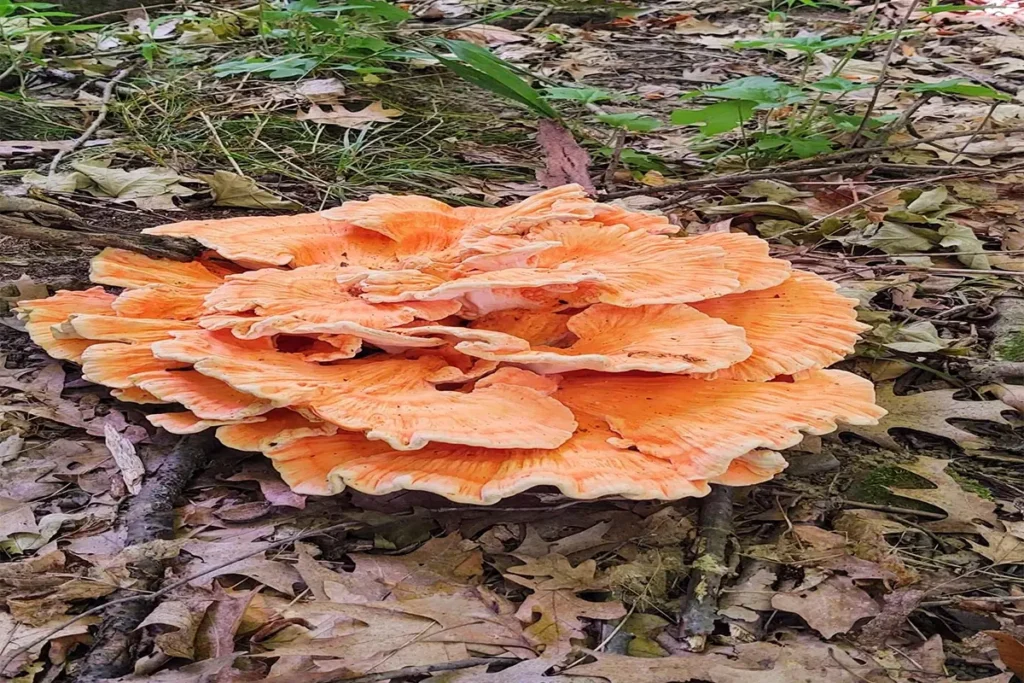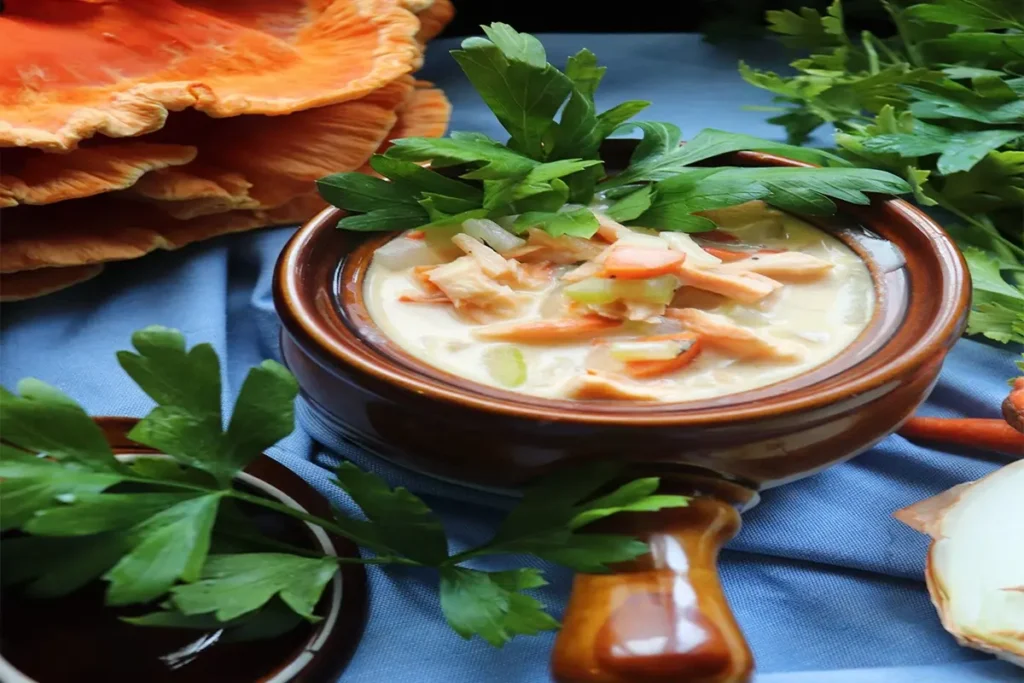Introduction to Chicken of the Woods Recipe: A Culinary Delight
Welcome to our detailed exploration of the Chicken of the Woods Recipe, a culinary gem for both adventurous cooks and nature enthusiasts. In this guide, we delve into the world of this unique mushroom, offering insights into its preparation, cooking techniques, and nutritional benefits. Whether you’re new to foraging or an experienced chef, our comprehensive guide will unveil the secrets to mastering dishes with this versatile and flavorful ingredient.
What is Chicken of the Woods?
Chicken of the Woods, not to be confused with your regular poultry, is a vibrant mushroom, known scientifically as Laetiporus. This fungus, often spotted in bright orange and yellow hues, grows predominantly on oak trees. It’s famed for its remarkable resemblance in taste and texture to chicken, making it a popular choice among vegetarians and vegans. But it’s not just a meat substitute; this mushroom is a star in its own right, offering a unique flavor profile that can transform any dish.
Nutritional Benefits
When it comes to health, Chicken of the Woods is no slouch. This mushroom is not only a feast for the eyes but also a powerhouse of nutrition. It’s low in calories, yet rich in protein, fiber, and essential minerals like potassium and vitamin C. Incorporating this fungal delicacy into your diet can be a game-changer, especially if you’re looking for gluten-free or plant-based options. Moreover, the nutritional benefits of mushrooms are well-documented, making Chicken of the Woods a smart choice for health-conscious food lovers.
In the next section, we’ll explore how to select and prepare Chicken of the Woods, ensuring you get the best out of this wild mushroom. Stay tuned for some foraging tips and tricks that will set you up for culinary success!
Historical and Cultural Significance
Chicken of the Woods, a mushroom steeped in history, has graced the tables of many cultures for centuries. Native American tribes revered it for its medicinal properties, often using it in traditional healing practices. In Europe, it was a prized find for forest foragers, valued both for its flavor and its abundance. This mushroom has also featured in various folklore tales, often symbolizing nature’s bounty and the interconnectedness of life. Understanding its historical and cultural background not only adds a layer of depth to our culinary exploration but also connects us to the rich tapestry of human-nature relationships.
Selecting and Preparing Your Chicken of the Woods Recipe Ingredients
Identifying and Harvesting
Foraging for Chicken of the Woods is an adventure in itself. This mushroom typically grows on dead or dying hardwood trees, such as oak, cherry, and beech. It’s easily identifiable by its bright orange and yellow colors. However, caution is key! Ensure you’re picking the right mushroom, as there are look-alikes that aren’t edible. If you’re new to foraging, consider tagging along with an experienced forager or consult a reliable guide. Remember, sustainable foraging practices are crucial – take only what you need and leave some behind for nature’s balance.
Cleaning and Storage Tips
Once you’ve harvested your Chicken of the Woods, the next step is cleaning and storage. Gently brush off any dirt or debris – washing them can make them soggy. If you must rinse, do it quickly and pat them dry immediately. These mushrooms can be stored in the refrigerator for up to a week. For longer storage, consider drying or freezing them. Drying intensifies their flavor and is perfect for soups and stews, while freezing is ideal for recipes where you’d prefer a meatier texture.
In the upcoming section, we’ll dive into an array of tantalizing recipes that showcase the versatility of Chicken of the Woods. From breakfast to dinner, there’s a recipe for every occasion!
Pairing Chicken of the Woods with Other Ingredients
The robust texture and chicken-like flavor of Chicken of the Woods make it a versatile ingredient in the kitchen. It pairs wonderfully with garlic and onions, enhancing its earthy tones. Herbs such as thyme, rosemary, and sage bring out its natural flavors, while a splash of white wine can add a delightful zing. For a heartier dish, combine it with root vegetables or fold it into creamy risottos. These pairings not only elevate the mushroom’s taste but also create a symphony of flavors in every dish.
Creative Chicken of the Woods Recipes for Every Meal
Breakfast Recipes
Kickstart your day with a twist on classic breakfast dishes using Chicken of the Woods. Imagine a hearty mushroom hash brown, where the mushroom’s meaty texture complements the crispy potatoes perfectly. Or, how about a vegan-friendly scramble? Just sauté the mushroom with your favorite veggies, and you’ve got a breakfast that’s not only delicious but also packed with nutrients.
Lunch and Dinner Recipes
The versatility of Chicken of the Woods shines in lunch and dinner recipes. For a comforting meal, try incorporating it into a creamy risotto or a rich, flavorful soup. The mushroom’s texture holds up well, making it ideal for stews and casseroles. If you’re in the mood for something exotic, why not experiment with a Chicken of the Woods curry? The mushroom’s ability to absorb flavors makes it a fantastic substitute in traditional meat-based curries.
Snacks and Appetizers
Chicken of the Woods can also be a showstopper in snacks and appetizers. Think of crispy mushroom fries or a savory tart where the mushroom is the star. These dishes are not only a delight to the palate but also a conversation starter, thanks to the unique ingredient.
International Cuisine Variations
This mushroom’s adaptability extends to international cuisines as well. From Asian-inspired stir-fries to Italian-style pastas, Chicken of the Woods can be a global traveler in your kitchen. Its ability to mimic chicken makes it a fantastic ingredient in dishes like fajitas or tacos, offering a plant-based option without compromising on flavor.
In the next section, we’ll explore various cooking techniques to help you make the most out of your Chicken of the Woods dishes. Whether you’re a fan of baking, grilling, or sautéing, there’s a method for everyone!
Sustainability and Environmental Impact
Foraging for Chicken of the Woods is more than a culinary pursuit; it’s a practice that requires mindfulness about our environment. This mushroom plays a crucial role in decomposing dead wood, thus contributing to the health of forest ecosystems. Sustainable foraging means taking only what you need and ensuring that the mushroom can continue to grow. It’s also important to forage in areas free from pollutants to avoid contamination. By practicing responsible foraging, we can enjoy nature’s gifts without disrupting the delicate balance of our ecosystems.
This link provides practical advice on how to ethically and sustainably harvest wild mushrooms, including Chicken of the Woods, which aligns well with the article’s focus on responsible foraging.
Mastering Cooking Techniques for Your Chicken of the Woods Recipes
Sautéing and Frying
Sautéing is a splendid way to cook Chicken of the Woods, especially for beginners. It’s simple yet effective in bringing out the mushroom’s natural flavors. Start with a hot pan, add a bit of oil, and let the mushroom pieces sizzle until they’re golden brown. This method is perfect for creating a crispy exterior while keeping the inside tender. Frying, on the other hand, gives you that irresistible crunch. Whether you’re making mushroom fries or a faux fried chicken, a light batter and a quick dip in hot oil can work wonders.
Baking and Grilling
Baking is a healthier alternative that still delivers on flavor. Marinate your Chicken of the Woods in your favorite herbs and spices, then bake until it’s perfectly cooked. This method is great for making mushroom steaks or adding a meaty texture to casseroles. Grilling, meanwhile, adds a smoky flavor that’s hard to resist. Brush the mushrooms with a bit of oil, season as desired, and grill them to perfection. It’s a fantastic way to enjoy the outdoors and cook a delicious, plant-based meal.
In the next section, we’ll discuss the health benefits and dietary considerations of Chicken of the Woods. Whether you’re vegan, vegetarian, or just looking to add more plant-based options to your diet, this mushroom is a nutritious and delicious choice.
For more insights on cooking techniques that can apply to both chicken and mushrooms, check out these Expert Tips for Juicy, Flavorful Cooking with thin chicken breasts.
Health Benefits in Chicken of the Woods Recipes
Vegan and Vegetarian Adaptations
Chicken of the Woods is a boon for those following vegan and vegetarian diets. Its meat-like texture makes it an excellent substitute in traditional meat dishes, offering a satisfying alternative without compromising on taste or texture. From vegan “chicken” nuggets to hearty vegetarian stews, this mushroom seamlessly adapts to various recipes, ensuring that plant-based meals are anything but boring.
Allergies and Precautions
While Chicken of the Woods is generally safe to eat, it’s important to be aware of potential allergies and precautions. Some individuals may experience mild reactions, especially when consuming the mushroom for the first time. It’s always a good idea to try a small amount initially. Additionally, ensure that the mushrooms are cooked thoroughly, as raw or undercooked Chicken of the Woods can be tough to digest.
In the next section, we’ll address some frequently asked questions about Chicken of the Woods, clearing up common queries and misconceptions. Whether you’re a seasoned forager or a curious cook, this section will provide valuable insights into this fascinating mushroom.
Expert Tips and Tricks
Gleaning wisdom from seasoned chefs and foragers can transform your Chicken of the Woods experience. Experts recommend looking for younger, tender mushrooms for the best flavor and texture. They also advise against washing the mushroom vigorously, as it can become waterlogged. Instead, gently brush off any dirt. When cooking, consider the mushroom’s dense structure – it can handle robust flavors and high heat. Experiment with different cooking methods like grilling or roasting to explore its range of flavors.
Frequently Asked Questions
Common Queries about Chicken of the Woods
- Can Chicken of the Woods be eaten raw?
- No, it’s not recommended to eat Chicken of the Woods raw. Cooking not only enhances its flavor but also makes it easier to digest.
- How do you know if Chicken of the Woods is safe to eat?
- Ensure it’s brightly colored, firm, and growing on hardwood. If you’re unsure, consult an experienced forager or a reliable guide.
- Can Chicken of the Woods cause allergic reactions?
- While rare, some people may have mild reactions. It’s wise to try a small amount first if you’re new to this mushroom.
- How long can you store Chicken of the Woods?
- In the fridge, it can last up to a week. For longer storage, drying or freezing is recommended.
- Are there any look-alikes to Chicken of the Woods?
- Yes, there are look-alikes, but they usually lack the vibrant orange and yellow colors. Always forage with caution.
- Can Chicken of the Woods be used in vegan cooking?
- Absolutely! Its meaty texture makes it a fantastic substitute in many dishes, from stews to stir-fries.
- What’s the best way to cook Chicken of the Woods?
- Sautéing, frying, baking, and grilling are all great methods. The key is to cook it thoroughly to bring out its best texture and flavor.
In the final section, we’ll wrap up our comprehensive guide on Chicken of the Woods. We hope this journey has been as enlightening for you as it has been exciting for us
Wrapping Up
As we conclude our journey through the world of Chicken of the Woods, it’s clear that this unique mushroom is more than just a culinary curiosity. It’s a versatile, nutritious, and delicious ingredient that can elevate a wide range of dishes, from simple breakfasts to elaborate dinners. Whether you’re a seasoned forager, a culinary enthusiast, or someone exploring plant-based options, Chicken of the Woods offers a world of possibilities.
Remember, the key to enjoying this mushroom lies in proper identification, preparation, and cooking. With its rich, meaty texture and ability to absorb flavors, it’s a fantastic addition to any kitchen. Plus, its health benefits make it a smart choice for those looking to add more plant-based ingredients to their diet.
We hope this guide has inspired you to experiment with Chicken of the Woods in your cooking adventures. Whether you’re whipping up a quick sauté or a complex curry, this mushroom is sure to impress. So, the next time you come across these vibrant fungi, consider the endless culinary creations you can craft. Happy cooking!


